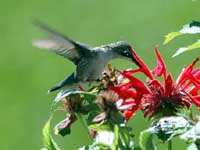About Hummingbirds
 |
| Sam Kulp |
People are fascinated by hummingbirds, which include North America's smallest bird, the Calliope Hummingbird, and the world's lightest bird, the Bee Hummingbird, which weighs only as much as two paperclips! Hummingbirds are often brightly colored and iridescent, and have a slender bill and a tongue that extends deep into flowers to sip nectar. The ability to flap their wings rapidly--on average about 50 times per second--enables hummingbirds to hover with ease. Despite their size, some migratory species travel more than thousands of miles, flying for hours at a time. All 328 species of hummingbirds are found exclusively in the Americas.
Why are hummingbirds important to the environment?
Hummingbirds are pollinators, and some plants have evolved long, tubular flowers to take advantage of hummingbirds' specialized method of sipping nectar. Native honeysuckles, penstemon, salvias, and other plants rely heavily on visits from hummingbirds for their own reproduction, as hummingbirds inadvertently collect pollen on their feathers and bill while feeding, and carry the pollen to the next flower.
According to Birdlife International, 47 species of hummingbirds are threatened, endangered, or vulnerable. Hummingbird habitat in North, Central, and South America is being lost to development and fragmentation, as well as to the exploitation of forested regions for the production of wood, coffee, and other crops. All of these changes negatively impact hummingbird populations.
Getting Started: What You Can Do
- Purchase products that protect and support tropical forests.
- Create a natural habitat in your yard that includes nectar-rich flowering plants, vines, shrubs, and trees. Even a window box can help. Hummingbirds especially like red tubular flowers.
- Put up hummingbird feeders to provide sugar water as supplemental food, which is especially critical during the fall and winter, when the birds are migrating.
- Install a constant source of water on your property in the form of a drip fountain or a fine misting device, for drinking as well as for bathing.
- Eliminate pesticides. Hummingbirds need protein, which they get from consuming spiders and small insects. The use of pesticides gets into the food chain and can kill hummingbirds.
- Encourage your neighbors to make their yards hummingbird friendly, as well to create a swath of habitat through the neighborhood-a valuable resource for migrating birds.
Credits to National Audubon Society